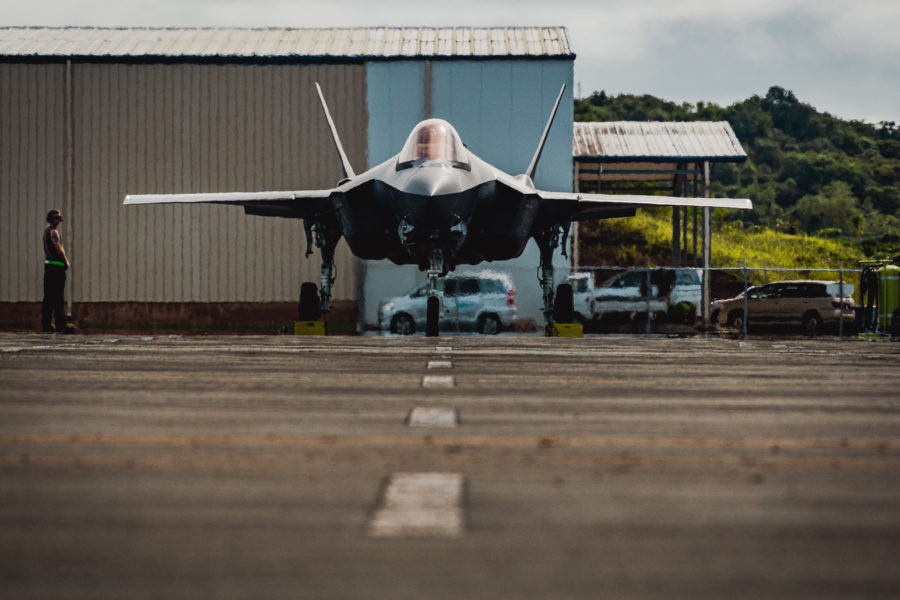JOINT REGION MARIANAS, Guam—Laid out across a vast wooden table made in the woodshop of a Navy ship repair facility in Guam in 1967 was a map of the Pacific Ocean island chains of the Northern Marianas, Palau, and Micronesia.
As large as the map was—spread out at the rounded head of the historic table that once hosted a meeting between President Lyndon B. Johnson and South Vietnamese representatives—it showed only the small region of the South Pacific where the exercise Valiant Shield took place June 6-17. Across thousands of miles of Pacific Ocean, the exercise included 15 surface ships, more than 200 aircraft, and about 13,000 personnel from across the services.
Aside from practicing fifth-generation agile combat employment and joint fires integration to sink a decommissioned Navy frigate, the biennial exercise demonstrated the progress the Air Force has made in adding partners in the region while also testing how far is too far to disperse and how to incorporate more platform types.
“This is a pretty … extensive swath of area,” Joint Region Marianas commander Navy Rear Adm. Benjamin Nicholson told Air Force Magazine during a visit to his headquarters office in Guam.
“All throughout Palau, we’ve got a number of different forces operating there,” Nicholson explained before the exercise concluded. “We’ve got assets from our naval construction battalion, the Seabees, that are down there. There’s Marine Corps assets there. There’s Air Force assets. There’s Army assets.”
Nicholson reached across the table to point to the southernmost island of the Palau island chain, Angaur, in the Philippine Sea, to explain the Marine Corps’ role.

“The Marine Corps just recently did a HIMARS launch from Angaur, which was pretty neat down there. It’s the first time we’ve done something like that in a long time,” he said.
Expanding the ACE Portfolio
The Air Force is expanding ACE operations beyond the Northern Mariana Islands, which include the U.S. territories Guam, Tinian, and Saipan. Now, PACAF can count on the Republic of Palau and the Federated States of Micronesia to practice landing, re-equipping, and quickly launching from unfamiliar, austere islands locations.
The result moves the Air Force closer to realizing the ACE operational concept to confound an adversary’s targeting by spreading out.
“We’re constantly trying to operationalize these concepts,” said Col. Jared Paslay, a Valiant Shield planner who spoke to Air Force Magazine by phone from PACAF’s headquarters in Hawaii after the exercise concluded.
“We’re trying to pedal as fast as we can and integrate as quickly as possible,” Paslay said.
He said one operational concept tested and deemed “widely successful across the joint force” involved joint all-domain command and control, known as JADC2.
In the test, with military comms cut, technicians passed encrypted messages over civilian communications infrastructure.
“Imagine the possibilities when you can actually use the local environment, like a cell phone tower or a Starlink terminal, to actually pass messages back and forth and continue to do a crisis response type of operation,” he said. “It was a massive enabler for not just the Air Force, but the entire joint force.”
Another element of the exercise involved F-35s practicing integrated air and missile defense, with the Army firing Patriot missile defense systems from Palau’s Roman Tmetuchl International Airport on the main island of Babeldaob.
“A lot of awesome firsts for a very important regional partner with the Palau piece,” Paslay said.
Another first was participation by MQ-9s from Creech Air Force Base, Nev., in what Paslay described as “expanding the envelope” of the ACE concept beyond fighters to include transport as well as intelligence, surveillance, and reconnaissance (ISR) aircraft—”all the other aspects that you would need as an air component and as a joint force to fight forward in a distributed operating environment,” he explained.
The ISR “drop-in,” as Paslay described it, helped the Air Force better understand what the ACE footprint for an MQ-9 should look like.
“How would you take a valuable asset like that and actually drop it in with a small footprint of folks, and launch and recover it forward?” he posed. “Trying to figure that out in a peacetime environment is a pretty big emphasis item for us—and I think there was a lot of goodness that was had by that, the MQ-9s out of Palau.”
Dispersion With Balance
With Valiant Shield, the Air Force learned a little more about how to disperse to multiple operating locations in the Pacific.
“In a contested, distributed operating environment, we’ve got to get light. We’ve got to get lean. We’ve got to cover down. We’ve got to bake resiliency into our support personnel so we can do a lot more from a versatility standpoint, with even less people than before,” he explained.
Paslay said that beyond the exercise’s South Pacific operational area—which included the so-called Second Island Chain of the Island Chain Strategy—Navy surface vessels were situated near the Korean Peninsula, Japan, and the Philippines, which constitute the First Island Chain; and command-and-control took place at Joint Base Pearl Harbor-Hickam, Hawaii, part of the Third Island Chain.
“So, for a couple of weeks of an exercise, it was a pretty large scope and scale geographically,” he said.
But deciding how much to disperse also requires balance.
“I want to disperse far enough away—that way I can mitigate an adversary’s kinetic attacks,” he said. “We’ll spread out to multiple operating locations that are far enough away to make sure that they’re survivable but they’re not so far away that they’re not sustainable. Otherwise, it is just an idea on paper, and it’s actually not executable.”

